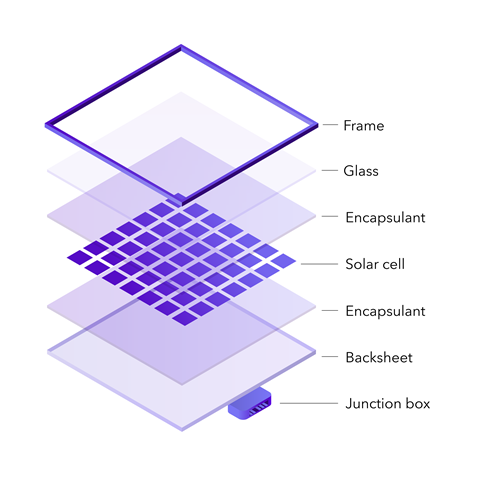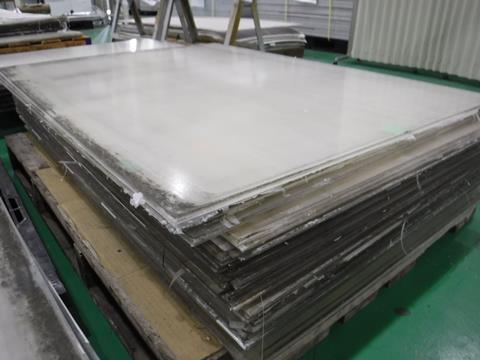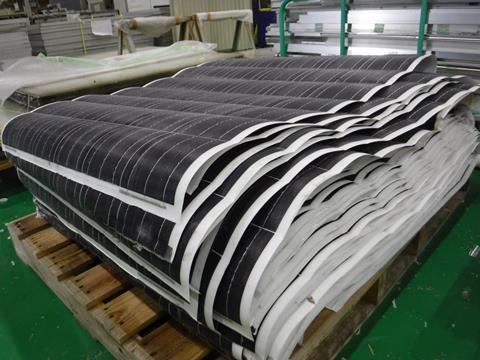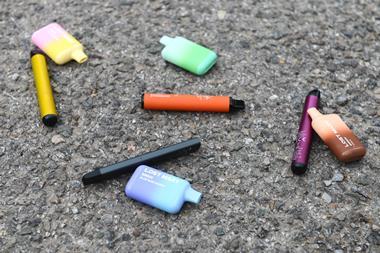Getting energy from the sun isn’t renewable until the panels are recyclable. James Mitchell Crow talks to the scientists making it happen
Among the regular bleak news about climate change and carbon emissions, the rapid uptake of photovoltaic (PV) solar technology is a bright spot. The number of new PV modules installed each year continues to outshine all but the sunniest of predictions. Projections of PV installation made even within the past five years, by the likes of the International Energy Agency (IEA) and the International Renewable Energy Agency (IRENA), are already proving to have underestimated the technology’s expansion.
‘PV uptake continues to grow at a fast rate,’ says Garvin Heath, a researcher at the US National Renewable Energy Laboratory in Colorado, and head of the IEA expert group fostering PV sustainability called Photovoltaics Power Systems Technology Collaboration Programme Task 12. From 1.4 gigawatts in 2000, the cumulative total capacity of installed PV reached around 50GW in 2010, and exceeded 600GW by the start of 2020. The rate of uptake is still accelerating.
But as PV leaders are well aware, the pathway to sustainable energy generation is not yet complete. A typical PV module is expected to have a 25–30 year working life. Today’s rapid growth in installed PV will be mirrored, a couple of decades down the track, by an equally sharp rise in PV panels ready to be retired. Heath and his Task 12 colleagues have estimated that the world will face a cumulative mass of 8 million tonnes of end-of-life PV modules by 2030, and 80 million tonnes by 2050, by which time it could represent more than 10% of global e-waste.
‘A lot of people have the misconception that putting solar panels on their roof solves the problem of sustainable energy generation,’ says Meng Tao, a solar researcher at Arizona State University in the US. ‘But there are two elements to it. One part is having a sustainable energy source – but the other part is having a sustainable technology to utilise that resource.’ Today, most used PV ends up in landfill, hardly a sustainable solution. But work to circularise the PV economy is well underway.
Spotlight on silicon
The end-of-life PV problem is widely acknowledged. In the EU, PV is already covered under Waste Electrical and Electronic Equipment (WEEE) regulations, which requires that used modules be recycled. Dedicated PV recycling facilities are now operating. But these processes are based on crushing the panels up, rather than trying to cleanly extract the high-quality silicon and other valuable materials they contain. The general consensus is that the silicon PV circular economy remains very much a work in progress. ‘We haven’t reached the end yet, despite the research undertaken,’ Heath says.
30–40,000 different silicon modules have been manufactured over the last three decades
Ongoing efforts to improve end of life module management are aimed squarely at crystalline silicon. First, because crystalline silicon has long been the dominant PV technology, and currently commands a 95% market share. And second, because crystalline silicon’s nearest PV rival, thin film cadmium telluride, is already efficiently being recycled.
The biggest cadmium telluride PV maker , First Solar, has been refining its end-of-life module recycling process for more than a decade – by necessity, given the toxic nature of tellurium and particularly, cadmium. ‘Because the word cadmium is in the name, First Solar has had a microscope on their management of cadmium through its lifecycle from the get-go,’ says Heath. ‘They are now on the third version of their recycling system, and are by far the largest commercial recycler of PV modules in the world.’
Silicon PV recycling poses different challenges. Whereas cadmium telluride PV is dominated by a single manufacturer, many companies make silicon PV modules, each to their own design. ‘Literally 30–40,000 different models of crystalline silicon modules have been manufactured over the last three decades,’ says Heath. ‘That is a lot of variation out there. There is no one chemical formula for what you’re going to find in a silicon PV module.’
One thing that can be depended on is that the module was not made to come apart easily. ‘PV modules have been designed to withstand the elements in harsh outdoor environments for 30 years,’ says Heath. ‘There is a reason why it is a challenging issue to extract materials from them.’
Break it down
Although there is significant variety in the detail, silicon PV modules share a consistent general design. Each module contains multiple individual silicon solar cells, covered by a silver-based metallised grid. Each cell is electrically connected via copper tabbing, typically held in place by tin–lead solder. This structure is coated, front and back, with a polymeric encapsulant, normally polyethylene-co-vinyl acetate (EVA).

The EVA’s upper surface is bonded to a sheet of high clarity low-iron glass. The module underside is most commonly sealed by a backsheet of polyethylene terephthalate (PET) and polyvinyl fluoride (PVF), although the trend is to move to glass here too. An aluminium frame surrounds the module edges, and a junction box on the panel’s rear serves as the electrical connection point.
Moisture is the PV module’s ultimate enemy, and most likely cause of failure. Over the years out in the weather, water can slowly penetrate the EVA encapsulant, and corrode the interconnects. Hail damage or backsheet delamination can dramatically hasten the process.
‘It is usually the module that has died, not the individual silicon cells,’ says Richard Corkish, a PV researcher from the University of New South Wales in Australia. But the module’s component silicon cells themselves do slowly degrade. A PV module’s operator may decide, for economic reasons, to replace a working module when its performance falls below a threshold.
One form of PV circular economy would be to reuse old but functional modules, or at least to extract the functional individual cells from moisture-damaged modules (see box Reuse or recycle? below). But even if their lifetime can be extended, ultimately all modules will reach the end of their time in the sun.
The first issue, with potentially significant financial and environmental implications, is transporting used PV to a centralised recycling facility. But once there, the first couple of steps of PV module recycling are simple. ‘Removing the aluminium frame is pretty easy, and there’s a ready market for scrap aluminium,’ Corkish says. The junction box can be levered off and can go in normal e-waste recycling stream, to recover the copper it contains.
‘Then you are left with the laminate: glass, encapsulant, cell, encapsulants, tabbing, backsheet,’ Corkish says. From here, things become much more difficult. ‘You have to do something about the fact it is all very well stuck together with encapsulant.’
A process that just smashes it all up and then tries to separate doesn’t feel right to me
In the first commercial-level silicon PV module recycling plants, located in Europe, the approach so far has been to crush the laminate. It’s a low-cost approach – but mainly produces a low grade, low value, impure glass known as glass cullet. As glass makes up 70–80% of the module mass, and the aluminium a further 10%, this method does recycle most of the module. But the collected copper, aluminium and glass cullet only generates $3 per module, which is far below the cost of collecting and processing the module. Landfill remains a considerably cheaper option.
Some facilities also extract low-grade, low-value silicon from the crushed laminate. But from a materials point of view, as well as an economic one, dirty silicon and glass cullet seems a poor return from a stream of highly quality glass and extremely pure silicon cells. ‘A process that just smashes it all up and then tries to separate doesn’t feel right to me,’ Corkish says.
After producing a series of technical reports on PV recycling for the IEA, Heath and his Task 12 colleagues combined all the lessons they had learned to produce an R&D roadmap, laying out research priorities aimed at extracting more value from end-of-life crystalline silicon PV modules. ‘The material that we thought had the most potential for value increase, in terms of current approaches, is the silicon,’ Heath says. ‘There is a significant multiple of value increase you can get by moving from silicon that is metallurgical grade, around 98% pure, to silicon which is closer to solar grade, 9N [99.9999999%] to 13N pure.’
If you could extract high grade silicon, as well as the silver and additional copper from the mix, recycling revenue could jump significantly, Meng has calculated. ‘You can generate $9–10 of material, three times more than what is collected today,’ Meng says. ‘How we can increase the revenue from PV recycling is the focus of our research.’
Reuse or recycle?
‘From the environmental point of view, we should talk about PV reuse before we talk about recycling,’ says Richard Corkish from the University of New South Wales (UNSW) in Sydney, Australia. ‘If you’ve got a stream of old solar modules – perhaps from someone replacing a roof – some are probably fine and have a lot of life left in them. We are interested in looking at triage tools and processes for how we might quickly, cheaply and efficiently separate used PV modules for reuse, refurbishment, and recycling.’
Some of the technologies pioneered at UNSW for the quality control of new PV modules could be adapted for assessing PV panels in the field, Corkish argues. ‘We have a big programme of imaging cells and modules, particularly using photoluminescence or electroluminescence spectroscopy.’ By exciting the solar cell with light or electricity, and measuring the infrared light emitted, the panel’s performance can be assessed. ‘Photoluminescence allows you to do this remotely, by just shining light on it,’ Corkish says. ‘People are working on doing that in the field, handheld or from drones, to monitor use in situ. We are interested in applying those techniques to end of life.’
The big dream is to extract cells to bring them back to life through hydrogenation
Ideally, Corkish would like to develop the technique to the extent that it could form the basis of a certification scheme for used modules, promoting a second-hand PV market. ‘We’d like to have a method of saying “This module is still fine for 10 years, here’s a warranty”.’ As with all aspects of end-of-life PV treatment, the challenge is to assess the panels for minimal cost. ‘We have to do that in the context that new modules are getting cheaper all the time.’ Not just cheaper, but more efficient too.
And then there are PV modules where the module itself has failed, but some or all of the silicon cells within it remain functional – or could even be revived. Defects that accumulate in the silicon could potentially be repaired with the same hydrogenation technique used to improve new silicon wafer performance by filling efficiency-sapping defects in the structure. ‘The big dream is to extract cells to bring them back to life through hydrogenation,’ Corkish says.
But before hydrogenation is considered, there is the significant problem of liberating the silicon cells from the encapsulant that traps them within the solar module laminate. Most methods end up cracking the fragile silicon, although some progress has recently been made to extract intact silicon cells from the encapsulant using pyrolysis.
Heath and his fellow PV recycling roadmap authors, however, do not see great possibilities for extracting and reusing intact silicon cells. ‘We say de-emphasise this idea, as we just don’t see the potential for the balance of increased revenue to outweigh the additional cost, and we didn’t see a market.’ By the time they have been stripped from a rooftop and transported to a recycling facility, most modules are already going to be cracked. Even if intact, the cells in today’s modules use purer silicon than was used 20 or 30 years ago, and are a different size. ‘Why would you try to recover something nobody wants?’ Heath concludes.
But as silicon PV technology matures, one day we will reach the point where a silicon cell made 20 years ago is going to be very similar to a newly minted cell, Corkish counters. ‘A lot of people have given up on extracting intact cells,’ he admits. ‘I haven’t quite given up on it yet – but I’m not sure I’m right.’
Purity problems
The first step to accessing these materials is to cleanly break apart the EVA layer holding the glass front to the silicon and its attendant metal electrodes and interconnects. Various approaches have been attempted, including chemical methods to dissolve the EVA, and pyrolysis to selectively burn it in a furnace. Each method has pros and cons in terms of the cost of the process and the emissions or chemical wastes they generate.
One alternative, developed by Japanese company NPC, is to use a hot steel knife to cut the polymer between the cells and the glass. From the resulting sheet of exposed silicon cells, Meng has developed a process to individually separate out the silicon and various attached metals.

Initially, the team used nitric acid. ‘This dissolved almost all the silver, lead, copper and tin, just leaving the silicon behind,’ Meng says. After the tin precipitates out, an electrochemical process called electrowinning then pulls the remaining metals out of the nitric acid, one by one. ‘We apply a voltage to get the silver out. Once that is removed, we apply the next voltage to get the copper out. And then the last voltage to get the lead out.’
The team wasn’t able to completely recover the metals, however. ‘We can get only about 70% of the silver and 80% of the copper from the leachate,’ Meng says. The main problem seemed to be that, as the silver accumulated on the cathode, some silver would break off and redissolve. So the team, in collaboration with PV recycling start-up TG Technologies, looked to alternatives to nitric acid . ‘The key is that, when the silver detaches from the cathode, it should not redissolve in the leachate,’ Meng says. The team has demonstrated silver recovery of over 99%, Meng says. ‘Now we are looking into the other metals and what the recovery rate we can demonstrate with the same idea.’

Meanwhile, stripped of the metals, Meng is left with silicon that, by any usual measure, would be considered very pure. The challenge is that solar-grade silicon is perhaps the purest material humanity has ever created, up to 13N pure or more. Even with a perfect extraction system, the silicon in an end-of-life PV module is less pure than it was when the module was new. ‘Chemical transport processes at the interfaces of these modules while they are operating lead to impurities on the surface of the wafer,’ Heath says. Adding further complication, the exact impurities present are likely to vary from module to module, which poses questions for quite how far back down the purification pathway leading to solar-grade silicon the recovered material would have to be slotted back in. How to handle the recovered silicon remains one of the major areas for research that Heath and his colleagues highlighted in their recent roadmap.
‘Initially, we thought you should recover the silicon as solar-grade, to make cells again,’ says Meng. But the cost of bringing the silicon back to that level of purity has been off-putting. ‘Right now, we believe that we can recover the silicon wafer maybe 4N or 5N pure.’ That’s less pure than solar grade silicon, but purer than metallurgic grade. ‘However, there is currently no market for silicon between metallurgic and solar grade,’ he adds. ‘So we are looking into other markets for silicon, perhaps for lithium ion batteries.’ (See box Silicon in storage below)
Silicon in storage
Whether the silicon recovered from end-of-life PV modules could be cost-effectively turned back into solar-grade silicon remains the subject of active research. But even if the recycled silicon proves unsuitable for renewable energy generation, it could find a use in renewable energy storage.
Commercial silicon particles cost several hundred dollars per gram
‘Energy storage technologies will play a key role in the clean energy economy,’ says Ian Chen, a battery researcher at Deakin University in Victoria, Australia. ‘But current lithium-ion batteries are still not satisfactory in terms of their energy density, and slow charge and discharge.’ And then there’s the question of battery sustainability, he adds.
Chen and his team have been investigating the potential of silicon in the anode of lithium-ion batteries. Silicon offers a much higher theoretical energy density than the graphite currently used – but with the penalty of extreme electrode volume change during charging and discharging, resulting in rapid battery failure. One solution is to nano-size the silicon. ‘We have been working on that for several years using high-grade silicon nanoparticles,’ says Chen. ‘But commercial silicon particles cost several hundred dollars per gram, so we thought about ways to produce these ourselves at very low cost – and then we thought about recycled silicon from solar panels,’ says Chen.
The team has developed a way to turn recovered silicon into nanoparticles for battery use – an idea other researchers are also pursuing. Chen and his team are currently working on integrating the silicon nanomaterials into graphite to form a robust composite material. ‘We have functioning devices, some pretty nice performance results,’ says Chen.
Batteries are not the only energy storage technology that could use recycled silicon, notes Corkish. Several companies are developing technologies that use renewably generated electricity to heat up silicon, storing the energy thermally. The hot silicon can be used to drive a heat engine to release electricity, or to heat up air to drive a turbine in a combined heat and power unit. Trials of both technologies are underway.
Falling recyclability
What would make the biggest difference to PV module sustainability, Meng argues, would be to think about the problem more holistically. ‘Last century we were so laser-focused on technical advances, but without considering the whole lifecycle,’ he says. ‘Solar modules are designed for cost, efficiency, reliability – but not recyclability.’
If anything, solar cells look set to become harder, not easier, to recycle. One industry trend is to use double glass ‘bifacial’ modules, in which the opaque polymer backsheet is replaced by a second sheet of glass, which allows light to enter from either side of the panel, increasing efficiency. ‘But in terms of recyclability, there is no way you can separate these things, except to crush the glass. Then you cannot extract anything beyond the glass, aluminium and copper.’
Solar modules are designed for cost, efficiency, reliability – but not recyclability
Another issue is with silver. After silicon, the silver is probably the most expensive component in the module, so PV manufacturers have been reducing the silver content. ‘But when it comes to recycling, the intrinsic cost of the silver recovery step is the same, whether there is a little bit of silver or a lot. You reach the point [where] the silver you can recover doesn’t even cover the cost of extracting it. So we want the modules to have lots of silver, or no silver at all.’
Efforts to entirely replace the silver with a copper-based alternative are underway. ‘I hope solar cell companies are successful, but I hope they will also take recyclability into their module design,’ Meng says.
James Mitchell Crow is a science writer based in Melbourne, Australia













No comments yet